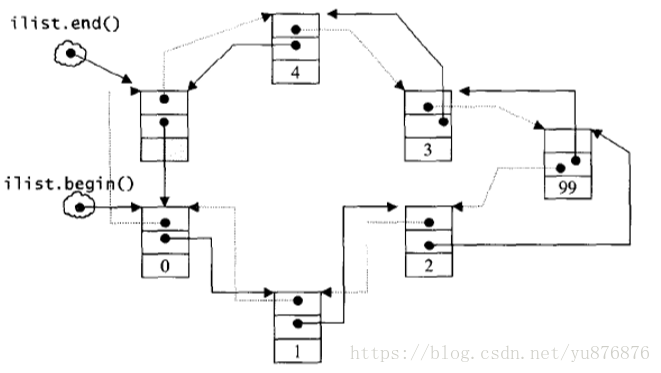list的底层结构
list底层是一个带头节点的双向循环链表,任意位置插入和删除时间复杂度0(1)

list迭代器
由于list底层是带头节点的双向循环链表,因此list的迭代器需要list的实现者自己提供
迭代器怎么实现呢?
迭代器的本质是指针,将指针封装出新的类型,指针有的操作,迭代器也视情况支持这些操作,比如:指针++,–,*,-> 等操作。迭代器在类中将这些操作重载出来即可,然后将list迭代器看作list的一种内部类型使用。
list的操作
Iterators: 迭代器
begin()
end()
rbegin() //重置后的开始
rend() //重置后的结尾
Capacity:
empty()
size() //有效元素个数
resize() //重置有效元素个数
Element access:
front //返回第一个引用
back //返回最后一个引用
Modifiers:
push_front
pop_front
push_back
pop_back
insert //任意位置插入
erase //任意位置删除
swap //交换两个list
clear //情空
Operations:
remove //按条件删除元素
remove_if
unique //去重
merge //合并两个有序链表
sort //单链表排序
reversr //单链表的逆置
#include<iostream>
#include<list>
using namespace std;
void TestList1()
{
//构造空的list
list<int>L1;
//构造10个值为1的list
list<int>L2(10, 1);
//构造用一段区间中的元素构造list
int arr[] = { 1, 2, 3, 4, 5, 6, 7, 8, 9, 0 };
list<int> L3(arr, arr + sizeof(arr) / sizeof(arr[0]));
//用L3取构造L4
list<int>L4(L3);
cout << "L1元素个数:" << L1.size() << endl;
cout << "L2元素个数:" << L2.size() << endl;
cout << "L3元素个数:" << L3.size() << endl;
cout << "L4元素个数:" << L4.size() << endl;
//遍历list1
list<int>::iterator it1 = L1.begin();
while (it1 != L1.end())
{
cout << *it1 << " ";
++it1;
}
cout << endl;
//遍历list2
list<int>::iterator it2 = L2.begin();
while (it2 != L2.end())
{
cout << *it2 << " ";
++it2;
}
cout << endl;
//遍历list3
list<int>::iterator it3 = L3.begin();
while (it3 != L3.end())
{
cout << *it3 << " ";
++it3;
}
cout << endl;
//遍历list4
list<int>::iterator it4 = L4.begin();
while (it4 != L4.end())
{
cout << *it4 << " ";
++it4;
}
cout << endl;
//逆向遍历list4
list<int>::reverse_iterator it5 = L4.rbegin();
while (it5 != L4.rend())
{
cout << *it5 << " ";
++it5;
}
cout << endl;
}
void TestList2()
{
list<int>L;
//尾插
L.push_back(1);
L.push_back(2);
L.push_back(3);
L.push_back(4);
L.push_back(5);
L.push_back(6);
list<int>::iterator it = L.begin();
while (it != L.end())
{
cout << *it << " ";
++it;
}
cout << endl;
//尾删
L.pop_back();
L.pop_back();
it = L.begin();
while (it != L.end())
{
cout << *it << " ";
++it;
}
cout << endl;
//头插
L.push_front(0);
it = L.begin();
while (it != L.end())
{
cout << *it << " ";
++it;
}
cout << endl;
L.pop_front();
it = L.begin();
while (it != L.end())
{
cout << *it << " ";
++it;
}
cout << endl;
任意位置的插入
//list<int>::iterator pos = find(L.begin(), L.end(), 2);
//if (pos != L.end())
// pos = L.insert(pos, 9);
//it = L.begin();
//while (it != L.end());
//{
// cout << *it << " ";
// ++it;
//}
//cout << endl;
任意位置删除、
//L.erase(pos);
//it = L.begin();
//while (it != L.end())
//{
// cout << *it << " ";
// ++it;
//}
//cout << endl;
//给list重新赋值
int arr[] = { 1,2,3, 4, 5, 6, 7, 8, 9 };
L.assign(arr, arr + sizeof(arr) / sizeof(arr[0]));
it = L.begin();
while (it != L.end())
{
cout << *it << " ";
++it;
}
cout << endl;
cout << "第一个元素" << L.front() << endl;
cout << "第一个元素" << L.back() << endl;
}
void TestList3()
{
int arr[] = { 1, 2, 3, 4, 5, 6, 7, 8, 9 };
list<int>L(arr, arr + sizeof(arr) / sizeof(arr[0]));
list<int>::iterator it = L.begin();
while (it != L.end())
{
cout << *it << " ";
++it;
}
cout << endl;
L.remove(3); //按值删除
it = L.begin();
while (it != L.end())
{
cout << *it << " ";
++it;
}
cout << endl;
class Odd
{
public:
bool operator()(int value)
{
return value & 0x01;
};
};
L.remove_if(Odd());
it = L.begin();
while (it != L.end())
{
cout << *it << " ";
++it;
}
cout << endl;
}
void TestList4()
{
int arr[] = { 1, 2, 5, 3,1, 2, 3, 4, 5,7,6, 8, 9 };
list<int>L(arr, arr + sizeof(arr) / sizeof(arr[0]));
L.unique();
list<int>::iterator it = L.begin();
while (it != L.end())
{
cout << *it << " ";
++it;
}
cout << endl;
L.sort();
it = L.begin();
while (it != L.end())
{
cout << *it << " ";
++it;
}
cout << endl;
L.unique();
it = L.begin();
while (it != L.end())
{
cout << *it << " ";
++it;
}
cout << endl;
//class Three
//{
//public:
// bool operator()(int left, int right)
// {
// return 0 == (left + right) % 3;
// }
//};
//L.unique(Three());
//it = L.begin();
//while (it != L.end());
//{
// cout << *it << " ";
// ++it;
//}
//cout << endl;
}
void TestList5()
{
list<int>L;
L.push_back(1);
L.push_back(4);
L.push_back(6);
list<int>L2;
L2.push_back(2);
L2.push_back(3);
L2.push_back(8);
//将两个已序链表合并成为一个链表,合并后依然有序
L.merge(L2);
list<int>::iterator it = L.begin();
while (it != L.end())
{
cout << *it << " ";
++it;
}
cout << endl;
//反转链表
L.reverse();
it = L.begin();
while (it != L.end())
{
cout << *it << " ";
++it;
}
cout << endl;
}
int main()
{
//TestList1(); 构造及其遍历
//TestList2();
//TestList3();
//TestList4();
//TestList5();
return 0;
}
 菜鸟笔记
菜鸟笔记